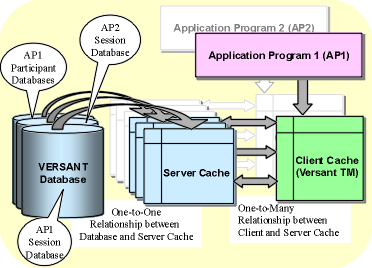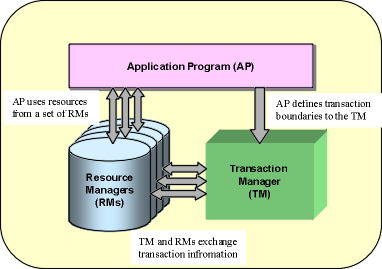An open transaction is a transaction controlled by an external process, called a Transaction Manager. In an open transaction, each phase of a commit or rollback to a VERSANT database can be controlled explicitly by a non-VERSANT application.
VERSANT system supports a number of different transaction protocol standards, including X/Open and its subset XA, with numerous C/VERSANT functions.
The flow of control in a generic transaction protocol system is something like the following (details differ from one protocol standard to another).
1. A Begin_Work() function starts the transaction. It registers the transaction with a Transaction Manager and creates a unique transaction identification number.
2. The application now invokes Resource Managers, reading and writing from the client machine or from databases, and sending requests to local and remote services.
3. When the Resource Managers get their first requests from a Transaction Manager, they join the associated transaction, telling the Transaction Manager that they wants to participate.
4. After the system answers all requests, the transaction calls a Commit_Work() function. This causes the Transaction Manager to begin a two-phase commit protocol. In Phase 1, the Transaction Manager asks all of the Resource Managers that have joined the transaction if they think the transaction is consistent and complete.
5. If all the Resource Managers respond "yes," the transaction is a correct transformation. The Resource Managers record this fact in their individual transaction logs. The Resource Managers then release the locks on the messages, finish any other necessary functioning, and the transaction is complete.
6. If any Resource Manager votes "no" the commit fails, causing the Transaction Manager to orchestrate a rollback. The Transaction Manager reads the transaction's log, and for each log record, calls the Resource Manager that wrote the record, asking the Resource Manager to undo the transformation. Once all the undos are finished, the Transaction Manager calls all the Resource Managers that had joined the transaction to tell them that the transaction was aborted.
7. The Transaction Manager also handles transaction recoveries if a site or node fails. If a site fails, the transaction protocol system restarts all the resource managers. As part of the Transaction Managers' restart code, the Transaction Manager tells Resource Managers the outcome of all transactions that were in progress at the time of the failure. The Resource Manager updates the logs and reconstructs its state.
Typically, each site has its own Transaction Manager. This allows each site to operate independently from each other. If the transaction deals with remote sites during its execution, remote Transaction Managers handle their own part of the process.
VERSANT provides the following functions that support open transactions.
o_beginxact()
|
Start a transaction and assign a transaction identifier.
|
o_commitp1()
|
Commit phase 1.
|
o_commitp2()
|
Commit phase 2.
|
o_deleteZombieList()
|
Delete list of zombie transactions.
|
o_flush()
|
Flush specified objects.
|
o_getparticipants()
|
Get databases participating in transaction.
|
o_getxid()
|
Get transaction identifier.
|
o_getZombieCount()
|
Get zombie count.
|
o_getZombieIndex()
|
Get zombie index.
|
o_getZombieList()
|
Get zombie list.
|
o_incZombieIndex()
|
Increment zombie index.
|
o_recover()
|
Get list of zombie transactions.
|
o_rollback()
|
Rollback transaction.
|
o_setflushobjects()
|
Set flush options.
|
o_setxid()
|
Set transaction identifier.
|
o_setZombieCount()
|
Set zombie count.
|
o_setZombieIndex()
|
Set zombie index.
|
o_unsetxid()
|
Remove transaction identifier.
|
o_xastatetransition()
|
Is XA call consistent.
|


